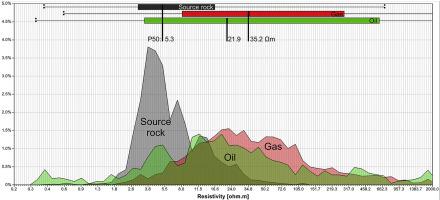Geoscience Frontiers ( IF 8.5 ) Pub Date : 2020-09-03 , DOI: 10.1016/j.gsf.2020.08.007 Kim Senger , Thomas Birchall , Peter Betlem , Kei Ogata , Sverre Ohm , Snorre Olaussen , Renate S. Paulsen

|
Marine controlled source electromagnetic (CSEM) data have been utilized in the past decade during petroleum exploration of the Barents Shelf, particularly for de-risking the highly porous sandstone reservoirs of the Upper Triassic to Middle Jurassic Realgrunnen Subgroup. In this contribution we compare the resistivity response from CSEM data to resistivity from wireline logs in both water- and hydrocarbon-bearing wells. We show that there is a very good match between these types of data, particularly when reservoirs are shallow. CSEM data, however, only provide information on the subsurface resistivity. Careful, geology-driven interpretation of CSEM data is required to maximize the impact on exploration success. This is particularly important when quantifying the relative resistivity contribution of high-saturation hydrocarbon-bearing sandstone and that of the overlying cap rock. In the presented case the cap rock comprises predominantly organic rich Upper Jurassic–Early Cretaceous shales of the Hekkingen Formation (i.e. a regional source rock). The resistivity response of the reservoir and its cap rock become merged in CSEM data due to the transverse resistance equivalence principle. As a result of this, it is imperative to understand both the relative contributions from reservoir and cap rock, and the geological significance of any lateral resistivity variation in each of the units. In this contribution, we quantify the resistivity of organic rich mudstone, i.e. source rock, and reservoir sandstones, using 131 exploration boreholes from the Barents Shelf. The highest resistivity (>10,000 Ωm) is evident in the hydrocarbon-bearing Realgrunnen Subgroup which is reported from 48 boreholes, 41 of which are used for this study. Pay zone resistivity is primarily controlled by reservoir quality (i.e. porosity and shale fraction) and fluid phase (i.e. gas, oil and water saturation). In the investigated wells, the shale dominated Hekkingen Formation exhibits enhanced resistivity compared to the background (i.e. the underlying and overlying stratigraphy), though rarely exceeds 20 Ωm. Marine mudstones typically show good correlation between measured organic richness and resistivity/sonic velocity log signatures. We conclude that the resistivity contribution to the CSEM response from hydrocarbon-bearing sandstones outweighs that of the organic rich cap rocks.
中文翻译:

巴伦支架上储层砂岩和有机质丰富页岩的电阻率:解释CSEM数据的意义
海洋控制源电磁(CSEM)数据已在过去十年的Barents陆上石油勘探期间得到了利用,特别是用于降低上三叠纪至中侏罗统Realgrunnen子群的高孔隙度砂岩油藏的风险。在此贡献中,我们比较了含水和含烃井中CSEM数据的电阻率响应与电缆测井的电阻率。我们表明,这些类型的数据之间有很好的匹配,特别是在储层较浅的情况下。但是,CSEM数据仅提供有关地下电阻率的信息。需要对CSEM数据进行仔细的,地质驱动的解释,以最大程度地影响勘探成功。当量化高饱和含烃砂岩和上盖岩的相对电阻率贡献时,这一点尤其重要。在目前的情况下,盖金包括赫金根组的有机质丰富的上侏罗统-早白垩纪页岩(即区域性烃源岩)。由于横向电阻当量原理,储层及其盖岩的电阻率响应已合并到CSEM数据中。因此,必须同时了解储层和盖层岩的相对贡献以及每个单元中任何侧向电阻率变化的地质意义。在这项贡献中,我们量化了有机质丰富的泥岩(即烃源岩和储层砂岩)的电阻率,利用Barents Shelf的131个勘探井。在含烃的Realgrunnen子组中,最高电阻率(> 10,000Ωm)明显,据报道有48个钻孔,其中41个用于本研究。产层电阻率主要由储层质量(即孔隙度和页岩分数)和流体相(即气,油和水饱和度)控制。在所研究的井中,以页岩为主的赫金根组比背景(即下伏地层和上覆地层)具有更高的电阻率,尽管很少超过20Ωm。海洋泥岩通常在测得的有机富度与电阻率/声速测井特征之间显示出良好的相关性。











































 京公网安备 11010802027423号
京公网安备 11010802027423号